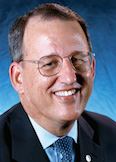The Continuing Partnership
Posted on May 21, 2010At his inaugural as UNC president in 1914, Edward Kidder Graham of the class of 1894 spoke of the special relationship between the nation’s first state university and the people of North Carolina. The boundaries of institution and state, he said, should be considered coterminous, and his sentiment continues to ring true. Over many generations, Carolina faculty have addressed North Carolina’s most difficult challenges as well as educated North Carolina’s best and brightest for service and leadership in all the professions and in every corner of North Carolina and beyond.

Doug Dibbert ’70
As the short session of the N.C. General Assembly convenes, legislators must again adjust the state’s budget to reflect the lower-than-anticipated revenues. Last year, under the leadership of President Erskine Bowles ’67, the UNC System made permanent administrative cuts of 18 percent while keeping permanent academic cuts to 0.3 percent. Any additional permanent cuts in the coming years would compromise the academic core and force Carolina and other UNC System universities to increase class size, reduce sections, cut faculty positions, shorten library and lab hours, and reduce advising and tutoring.
Besides minimizing any additional cuts, it will be important that the General Assembly adopt a UNC System Board of Governors’ proposal for tuition increases that would allow the revenues generated to remain on the campuses (rather than flow to the state’s General Fund) where they would be deployed to need-based financial aid and retention and graduation initiatives. The General Assembly also should restore $12 million in cuts for need-based financial aid, preserve the existing $11 million for need-based financial aid and provide an additional $22.8 million to cover the increased need for financial aid.
For nearly two decades, our campus has been challenged to become more self-sufficient, and as the chart below reflects, our students, faculty and alumni have responded.
Carolina’s increasing self-sufficiency is reflected in the steadily declining percentage of our budget coming from state appropriations – from 42.5 percent in 1985-86 to 29.5 percent in 1999-2000 to 23.4 percent in 2008-09. (Carolina’s 23.4 percent compares to the University of Virginia’s 9.5 percent.)
It is the continuing partnership among North Carolina taxpayers, reflected through vital appropriations by the General Assembly; generous Carolina alumni and friends, reflected in their philanthropic gifts; remarkably innovative faculty, who continue to earn ever-increasing research funding in a highly competitive environment; and our students’ still modest but important tuition, that we all come together to nourish our internationally respected University.
Given birth in the 18th century, nurtured through a challenging 19th century, recognized internationally in the 20th century, our University’s enduring commitment to service and excellence is without parallel today. The partnership that provides the foundation upon which Carolina was built and continues to thrive must be sustained and enhanced. Chancellor Holden Thorp ’86 and his leadership team will continue to work in partnership with Carolina’s faculty to provide students and taxpayers world-class teaching, research and service.
Alumni can help not only with continuing, generous financial support but also with our advocacy with legislators and with intellectually curious students across the country who, by becoming UNC students, also are on the road to becoming Carolina alumni. May our special partnership continue.
Yours at Carolina,

Douglas S. Dibbert ’70
